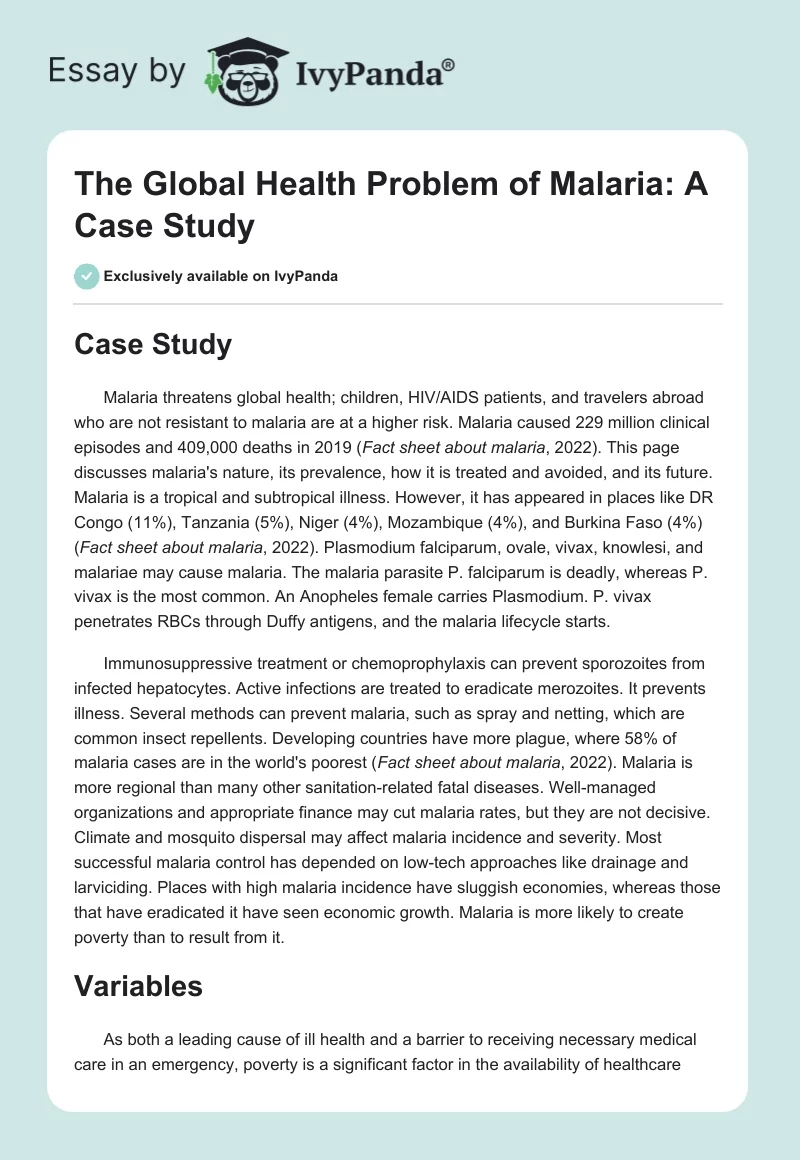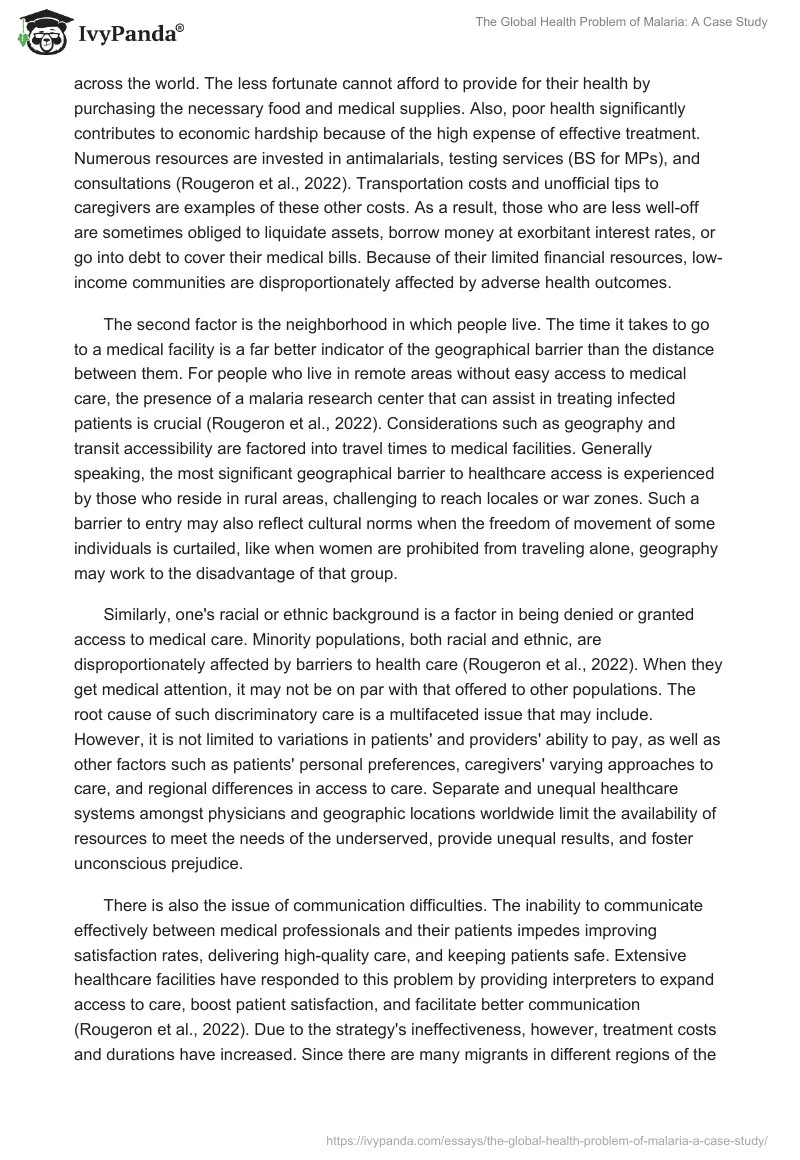Case Study
Malaria threatens global health; children, HIV/AIDS patients, and travelers abroad who are not resistant to malaria are at a higher risk. Malaria caused 229 million clinical episodes and 409,000 deaths in 2019 (Fact sheet about malaria, 2022). This page discusses malaria’s nature, its prevalence, how it is treated and avoided, and its future. Malaria is a tropical and subtropical illness. However, it has appeared in places like DR Congo (11%), Tanzania (5%), Niger (4%), Mozambique (4%), and Burkina Faso (4%) (Fact sheet about malaria, 2022). Plasmodium falciparum, ovale, vivax, knowlesi, and malariae may cause malaria. The malaria parasite P. falciparum is deadly, whereas P. vivax is the most common. An Anopheles female carries Plasmodium. P. vivax penetrates RBCs through Duffy antigens, and the malaria lifecycle starts.
Immunosuppressive treatment or chemoprophylaxis can prevent sporozoites from infected hepatocytes. Active infections are treated to eradicate merozoites. It prevents illness. Several methods can prevent malaria, such as spray and netting, which are common insect repellents. Developing countries have more plague, where 58% of malaria cases are in the world’s poorest (Fact sheet about malaria, 2022). Malaria is more regional than many other sanitation-related fatal diseases. Well-managed organizations and appropriate finance may cut malaria rates, but they are not decisive. Climate and mosquito dispersal may affect malaria incidence and severity. Most successful malaria control has depended on low-tech approaches like drainage and larviciding. Places with high malaria incidence have sluggish economies, whereas those that have eradicated it have seen economic growth. Malaria is more likely to create poverty than to result from it.
Variables
As both a leading cause of ill health and a barrier to receiving necessary medical care in an emergency, poverty is a significant factor in the availability of healthcare across the world. The less fortunate cannot afford to provide for their health by purchasing the necessary food and medical supplies. Also, poor health significantly contributes to economic hardship because of the high expense of effective treatment. Numerous resources are invested in antimalarials, testing services (BS for MPs), and consultations (Rougeron et al., 2022). Transportation costs and unofficial tips to caregivers are examples of these other costs. As a result, those who are less well-off are sometimes obliged to liquidate assets, borrow money at exorbitant interest rates, or go into debt to cover their medical bills. Because of their limited financial resources, low-income communities are disproportionately affected by adverse health outcomes.
The second factor is the neighborhood in which people live. The time it takes to go to a medical facility is a far better indicator of the geographical barrier than the distance between them. For people who live in remote areas without easy access to medical care, the presence of a malaria research center that can assist in treating infected patients is crucial (Rougeron et al., 2022). Considerations such as geography and transit accessibility are factored into travel times to medical facilities. Generally speaking, the most significant geographical barrier to healthcare access is experienced by those who reside in rural areas, challenging to reach locales or war zones. Such a barrier to entry may also reflect cultural norms when the freedom of movement of some individuals is curtailed, like when women are prohibited from traveling alone, geography may work to the disadvantage of that group.
Similarly, one’s racial or ethnic background is a factor in being denied or granted access to medical care. Minority populations, both racial and ethnic, are disproportionately affected by barriers to health care (Rougeron et al., 2022). When they get medical attention, it may not be on par with that offered to other populations. The root cause of such discriminatory care is a multifaceted issue that may include. However, it is not limited to variations in patients’ and providers’ ability to pay, as well as other factors such as patients’ personal preferences, caregivers’ varying approaches to care, and regional differences in access to care. Separate and unequal healthcare systems amongst physicians and geographic locations worldwide limit the availability of resources to meet the needs of the underserved, provide unequal results, and foster unconscious prejudice.
There is also the issue of communication difficulties. The inability to communicate effectively between medical professionals and their patients impedes improving satisfaction rates, delivering high-quality care, and keeping patients safe. Extensive healthcare facilities have responded to this problem by providing interpreters to expand access to care, boost patient satisfaction, and facilitate better communication (Rougeron et al., 2022). Due to the strategy’s ineffectiveness, however, treatment costs and durations have increased. Since there are many migrants in different regions of the world, the inability to communicate effectively is a significant factor limiting access to healthcare. People also often travel for various reasons, including employment and leisure. It might be challenging to communicate with medical staff if you get sick when visiting a foreign place and do not understand the local language.
Other factors, such as disability, can also impact healthcare access. Disabled people confront several obstacles in gaining access to medical treatment. Healthcare providers and other healthcare industry members often show bias and discrimination toward patients with disabilities (Rougeron et al., 2022). Second, owing to poor training and skills development, many care providers are uninformed about the rights and health requirements of individuals with disabilities. Thirdly, those who are disabled may have trouble getting to healthcare facilities because of physical obstacles. Some medical facilities, for instance, may not accommodate those with mobility impairments since they are only accessible by stairs. Lack of ramps or wide enough entrances are some examples of physical impediments.
References
Fact sheet about malaria. (2022). World Health Organization (WHO). Web.
Rougeron, V., Boundenga, L., Arnathau, C., Durand, P., Renaud, F., & Prugnolle, F. (2022). Correction: A population genetic perspective on the origin, spread and adaptation of the human malaria agents Plasmodium falciparum and Plasmodium vivax. FEMS Microbiology Reviews, 46(4). Web.


